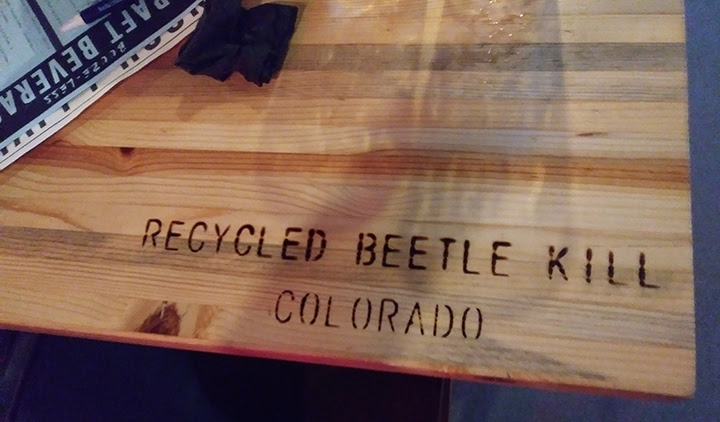 One of my colleagues sent me a photo from a local happy hour venue a couple of weeks ago.
One of my colleagues sent me a photo from a local happy hour venue a couple of weeks ago.
It was a disturbing photo.
The venue is fairly new and within walking distance of my office. It attracts a young and impressionable crowd, including a lot of workers from the Capitol Building.
 The photo demonstrates just how poorly California has managed crises that involve forests and other natural resources.
The photo demonstrates just how poorly California has managed crises that involve forests and other natural resources.
It shows one of the many new wooden tables in the venue. Stamped right on the table, in clear view, were the words “Recycled Beetle Kill….Colorado”.
Colorado, like California, has forests that have been infested with bark beetles. A combination of events, including climate-disruption and drought, have made the infestation deadly. In California forests, there are estimated to be more than 100 million dead trees.
Most of those California trees are in remote areas, not near homes or communities, and can be safely left to deteriorate in place, replenishing soil and supporting wildlife. But a big chunk are in rural neighborhoods. They endanger homes and people because they could fall over at the wrong time with crushing weight. So at least 1.5 million have been necessarily cut down.
What to do with those downed trees?
The former Brown Administration’s answer—with which past legislatures concurred, even as recently as last August—was to extend the life of highly polluting incinerators, require utilities to buy over-priced electricity from those incinerators, load the trees onto polluting trucks, and then haul them to the incinerators to burn.
So, we end up with more air pollution in California. And we buy beetle-kill tables from Colorado, where someone saw a job-creating opportunity, not just incinerator fuel.
Jerry Brown was great at addressing environmental issues that could be answered with new technology. He was not good at resolving environmental challenges that involved nature and natural resources.
As climate change impacts forced many eyes to focus wildlands and fires, Brown and the legislature responded by listening to the logging industry’s advice to suspend certain timber harvest oversight laws, accelerate so-called thinning, and extend the incinerator contracts.
Unfortunately, as fire experts have noted time and again, those measures won’t save communities. What will save communities is to focus on protecting homes through what fire experts call home hardening.
Home hardening includes a list of things that can be done to make homes more fire resistant. These include making sure there are no easy openings for embers blown in from distant fires to get into attics or basements. It means making sure rain gutters aren’t collecting dried pine needles. It can include screening attic vents, installing sprinkler systems to wet down homes and communities before embers arrive, replacing roofs and siding with fire-resistant materials.
It also includes defensible space. Fire experts say that defensible space extends from the front door to 100 feet out from the house. Defensible doesn’t mean removing all vegetation within that space. It basically means maintaining the vegetation to keep out dead, flammable materials. Google “defensible space” and “home hardening” and dozens of good links to valuable information will pop up.
This year, we have a new governor. Gavin Newsom barely had a chance to celebrate his electoral win before another wildfire—the most damaging in California history—hit Paradise. Since then, he and his growing team of appointees have had to learn a lot about fire and wildlands.
Recently, Sierra Club California teamed up with allies at The John Muir Project, California Chaparral Institute, Center for Biological Diversity and the Leonardo DiCaprio Foundation to send a letter to Governor Newsom that provides a thoughtful explanation of wildfire behavior in California and the need to focus on home hardening.
We also co-sponsored with Ebbetts Pass Forest Watch a briefing for legislative staff by policy, wildlands and fire experts about how to best protect homes and manage wildlands in the new climate changed world. You can see a video of that panel here.
Governor Newsom will have a choice in the coming months. He can take either of two paths. He can follow his predecessor’s approach to wildlands, forests and fire and just seek out the advice of the industries that stand to profit from less enlightened policies. Or he can seek a less polluting path that will deploy resources to where they will do the most good with the least harm.
He can put an end to the incinerator sham and instead accelerate efforts to shift biomass to other less-polluting uses, from garden mulch to furniture. He can focus new funds set aside for fire management on helping people—especially low-income people—who dwell in the wildland-urban interface to harden their homes.
We’ll keep pushing for him to take the less-polluting path.
